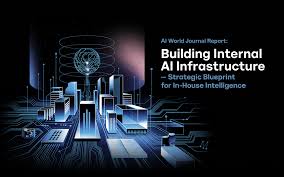https://theworldfinancialforum.com/participate/

Prepared by: Research & Strategy DivisionAudience: Executive Leadership, CTOs, Investors, Enterprise AI Teams Internal AI: Building In-House AI Infrastructure for…
As artificial intelligence (AI) continues to redefine the competitive landscape across industries, companies are increasingly realizing that relying solely on third-party AI services may not offer the flexibility, control, or scalability required for long-term growth. Building internal AI infrastructure isn’t just a technical challenge—it’s a strategic investment that can drive innovation, safeguard data, and create proprietary advantages. Here’s a blueprint for organizations looking to develop in-house AI capabilities.
Why Build Internal AI Infrastructure?
Before diving into how to build it, it’s important to understand why organizations are moving toward in-house AI infrastructure:
Data Control & Privacy: Internal systems allow for stricter data governance, crucial for industries like healthcare, finance, and government.
Customization: Tailor models and pipelines to unique business needs rather than adapting workflows around off-the-shelf solutions.
Cost Efficiency: While upfront investment is higher, in-house solutions can reduce long-term dependency costs on third-party platforms.
Competitive Edge: Proprietary AI models can be a differentiator, providing unique insights and capabilities.
Core Components of Internal AI Infrastructure
A robust internal AI infrastructure involves much more than just hiring data scientists. It requires orchestrating multiple components across hardware, software, and organizational processes:
1. Data Strategy & Architecture
AI begins with data. A successful AI initiative hinges on how data is collected, stored, cleaned, and accessed.
Data Lakes & Warehouses: Set up scalable storage solutions (e.g., AWS S3, Azure Data Lake) that integrate structured and unstructured data.
ETL Pipelines: Automate the Extract, Transform, Load (ETL) processes to ensure clean, real-time data flows to AI systems.
Data Governance: Implement policies to ensure quality, compliance (e.g., GDPR), and lineage tracking.
2. Compute Infrastructure
Depending on use cases (e.g., deep learning, NLP, computer vision), you’ll need high-performance compute resources.
On-Premise vs. Cloud: Cloud providers like AWS, Azure, and GCP offer flexible GPU/TPU compute instances, but hybrid models may be more cost-effective long-term.
Containerization: Use tools like Docker and Kubernetes to manage and scale AI workloads efficiently.
Model Deployment & Serving: Utilize model servers (e.g., TensorFlow Serving, TorchServe) and MLOps platforms to streamline deployment.
3. Model Development Environment
Give your AI team the right tools and workflows for experimentation and production.
Notebooks & IDEs: Support environments like Jupyter or VSCode with integrated access to compute and data.
Version Control: Track model code, data, and experiments using tools like DVC, MLflow, or Weights & Biases.
Model Training Pipelines: Automate training workflows and support hyperparameter tuning and retraining loops.
4. MLOps & Monitoring
Building models is only half the journey—maintaining them is where the real work begins.
CI/CD for ML: Establish pipelines for continuous integration, testing, and deployment of AI models.
Monitoring & Alerts: Track model performance, data drift, and latency in production environments.
Retraining Triggers: Automate model updates based on performance thresholds or new data availability.
5. Team Structure & Collaboration
Infrastructure isn’t just physical—it’s organizational.
Cross-Functional Teams: Build squads that include data engineers, ML engineers, product managers, and domain experts.
Training & Upskilling: Invest in ongoing education to keep teams aligned with rapidly evolving AI tools and techniques.
Governance & Ethics Boards: Establish oversight for responsible AI development and usage.
Conclusion
Building an internal AI infrastructure is a complex but rewarding endeavor. It gives organizations the autonomy to innovate at their own pace, the flexibility to build tailored solutions, and the competitive leverage that comes from owning critical intellectual property. By thoughtfully integrating technology, processes, and people, companies can turn AI from a buzzword into a sustainable engine for value creation.